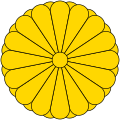Emperor Shirakawa
[7] He was the first emperor to ostensibly retire to a monastery, but in fact continue to exert considerable influence over his successor.
He attempted to regulate the shōen (manor) system, working to weaken the influence of the sekkan lines.
In 1096, on the occasion of his daughter's death, Shirakawa entered a monastery under the name of Yūkan (融観); and thus, he became a hō-ō (法皇), which is the title accorded to a former emperor who has become a monk.
Kugyō (公卿) is a collective term for the very few most powerful men attached to the court of the Emperor of Japan in pre-Meiji eras.
[25] [26] Unless otherwise noted (as BC), years are in CE / AD * Imperial Consort and Regent Empress Jingū is not traditionally listed.

